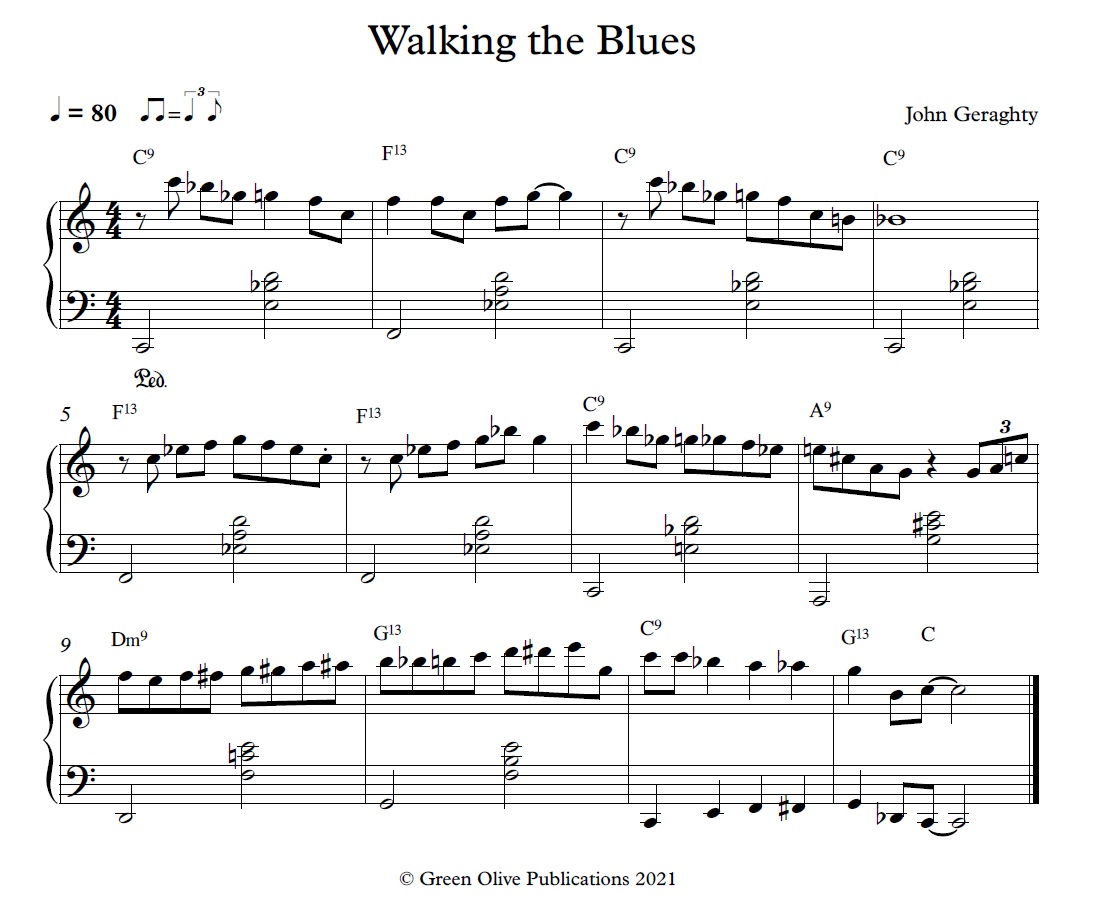Musician and teacher John Geraghty presents the penultimate lesson in his six-part series on Jazz Improvisation
In the previous four lessons of this series, we’ve looked at how to improvise in a band situation using backing tracks. This lesson will focus on accompanying yourself, i.e., you will be the bass player, rhythm player and soloist at the same time!
Walking bass line
Below shows one of the most recognisable bass lines in music history, played over a 12-bar blues chord progression.
Things to note...
- The C7 bass line is played twice in two-bar phrases. It is then transposed over F7 for two bars. The original two-bar phrase is then repeated again over C7. The bass in G7 and F7 uses only the first part of the two-bar phrase and then the bass line is repeated again over C7.
- The bass line keeps a steady beat using crotchet notes only.
- The root note starts on the first beat of the bar when a new chord appears, as shown in brackets.
- Each chord includes chord tones and the 6th note from their respective scales.

Here’s the same bass line with a popular, if not ‘cheesy’ ending, starting from bar 11-12.

Let’s add some ‘swing’ to it, either using chord tones (bar 2) or repeated notes (bar 4, as shown in the following music).
Practise adding the swing into various parts of the bar. The end of a two-bar phrase or the start of the second bar in a two-bar phrase would be good places to start.

Now that you have an idea of how a bass line can be played over a 12-bar blues progression, let’s try another bass line over the blues/jazz chord progression found in Lesson 4.
Things to note...
- From bars 7-12 below, all the chords use chord tones from their respective chords.
- Bar 10 features a descending arpeggio, starting from the third note (B) instead of the root note (G). This makes for a smoother transition from note C in Dm7 to note B in G7.

Chromatic passing notes
Chromatic passing notes pass through the chord, using notes that are not in the chord or scale. A simple way to use them is by playing a chromatic note either a semitone above or below the root note.
Things to note...
- The first arrow shows a descending chromatic passing note leading to F in bar 2. The second arrow shows an ascending chromatic passing note leading to note A in bar 8.
- Notes that are not in the chord are often played on softer beats, i.e., two or four. For example: Bar 7 shows note B on beat two and Ab on beat four.
- Everything sounds more jazzy.

Now let’s add in some scale runs, chord tones, triplets and chromatic passing notes to create an awesome jazz bass line!

Adding right-hand chords
Now that we’ve got a good idea on how bass lines work, let’s add in the left-hand, three-note rootless chord voicings that we looked at in Lesson 4. This time however, we’ll play them in the right hand in the same octave.
Use the rhythms learned in ‘Comping the chords’ as well as your own rhythms over the bass line.

Notes and rootless chords
So far in this lesson, we have looked solely at walking bass lines as a method of improvising over chord changes. Another way of improvising with the bass is by using both notes and chords.
A good way to start is by playing the root note of each chord on beat one and a rootless chord on beat three. Use the sustain pedal to create a smoother transition between note and chord in each bar.

Now let’s add in more single notes using either a chromatic passing note or the fifth of each chord on beat four in every bar.

Let’s add a touch of ‘swing’ to it, as shown in the music below.. Experiment using…
- Three different types of triplet rhythms (Bars 1, 4 and 6)
- A swing feel over the chords (Bars 10 and 12)
- Chord tones (Bar 5)

Below shows a new blues tune called Walking the Blues, based around the C blues scale and chromatic scale using the root/chord bass line. Once you have played it through without stopping, try…
- Learning the tune off by heart
- Adding in swing notes/chords to the left hand
- Improvising using C, F, G, D and the A blues scales over the appropriate chords
- Changing or adding your own jazz/blues licks over the chords

A final word...
What next?
- If you haven’t already done so, buy a Jazz ‘fake’ book. Pick your favourite Jazz tune from it and work out a bass line over the chord progression. Start with chord tones, then chromatic passing notes, scale runs and then triplets.
- Practise rootless chords in both the left hand and right hand. See Lesson 4.
- Find a singer or musician and start jamming!
Coming up in Part 6…
- Latin Jazz + new tune
Missed out on the first four parts of this series? You can view them below.
About the author
John Geraghty is a songwriter, music producer, pianist, author, teacher and entrepreneur. Although John is a classically trained pianist, his passion lies in songwriting and music producing. He has studied most genres of music including pop, jazz, gospel, country, and blues piano.
He is the author of Playing By Ear – A Songwriter's Way. His teaching method is simple and direct: "Leave out everything that is not necessary and teach the student what they really want to know.








